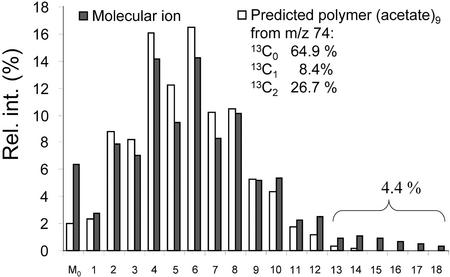Figure 6.
Predicted and measured relative abundance of mass isotopomers of C18:1 methyl ester, after growth on [U-13C6]Glc and unlabeled Suc. From the fragment C18:1(1-2), representing the terminal biosynthetic acetate unit, the distribution of mass isotopomers was predicted. The polymerization of nine acetate units to a C18 fatty acid molecule can be described by a binominal distribution (compare with Lee et al., 1992): (p + (q1 + q2))9. q1, Fraction of (13C1) acetate; q2, fraction of (13C2)-acetate; and p = 1 − q1 − q2, the fraction of (12C2) acetate. The expansion of this binominal distribution leads to the relative abundance of mass isotopomers (m0, m1, m2… m2n) of the fatty acid (Lee et al., 1992). After labeling with [U-13C6]Glc (diluted 20:80 with Suc, as related to hexose units), the fractional labeling in C18:1(1-2) was determined to q1 = 0.084, q2 = 0.267, and p = 0.649. This equals an average 13C content of 31%. The predicted distribution (white bars) and the measured molecular ion of C18:1 (black bars) are similar, indicating that the majority of fatty acid molecules was formed from acetate units labeled as measured in the fragment C18:1(1-2). However, a 4% fraction of fatty acid molecules was much higher labeled. Thus, during fatty acid biosynthesis, a small part of fatty acid molecules has been made mainly from labeled Glc, whereas the bulk of fatty acids was made by a homogeneous mixture of about 30% labeled and 60% unlabeled hexose units.

